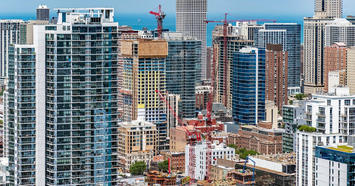
I have a difficult relationship with "upzoning", the reform of zoning ordinance codes that allows for a wider range of housing types and greater densities than typically seen in single-family-home dominant areas. It's clearly a positive strategy for cities with strong growth and demand for housing, and it clearly leads to the kind of urban development that I find most pleasing -- dense, walkable, a mix of uses, transit accessible. But cities that relax zoning standards without super-hot economies may be creating cities that end up being more unequal, not less.
The housing affordability crisis enveloping many of our nation's superstar coastal cities has taken front stage in urbanism discussions for years. Today's urbanists, especially those of the YIMBY (Yes In My Back Yard) persuasion, have been clear that tight zoning restrictions and exorbitant permitting costs have kept housing construction from keeping pace with demand. The solution is relaxed zoning and permitting that can increase the number of units and lower costs at the same time.
A year ago this hypothesis was put to the test. Yonah Freemark, a Ph.D. student in urban planning at MIT, released a paper last year that examined the impact of upzoning on property value on Chicago's North Side, a development hot spot. Freemark's findings were not what he expected. He found that 1) over a five year period, upzoning did not spur new housing construction, and 2) it actually drove prices upward, increasing the value of both existing units and proposed new development.
Freemark was clear to say that his study didn't "invalidate the laws of supply and demand," but that maybe in the short term (in this case, five years), the impact is higher prices and rents. That's similar to what a lot of urbanists said at the time of the paper's release.
However, another paper came out in late 2019 and wound up with the opposite conclusion. Another Ph.D. student, Xiaodi Li of NYU's Furman Center for Real Estate and Urban Policy, looked at the impact of new housing development on nearby apartment rents, but this time in New York City. While it appears the particular aspect of upzoning wasn't a variable in this study, New York did indeed undergo a massive citywide rezoning that increased allowable units through much of the Mike Bloomberg mayoral administration between 2002-2013. Li's finding was that with every 10% increase in housing stock, rents and sales prices within 500 feet of new development fall 1%. YIMBYs across the nation seemed to breathe a sigh of relief when this was reported. Their faith in the laws of supply and demand had been redeemed.
The question is, however, which study is right?
Read the rest of this piece at Corner Side Yard blog.
Pete Saunders is a writer and researcher whose work focuses on urbanism and public policy. Pete has been the editor/publisher of the Corner Side Yard, an urbanist blog, since 2012. Pete is also an urban affairs contributor to Forbes Magazine’s online platform. Pete’s writings have been published widely in traditional and internet media outlets, including the feature article in the December 2018 issue of Planning Magazine. Pete has more than twenty years’ experience in planning, economic development, and community development, with stops in the public, private and non-profit sectors. He lives in Chicago.
Photo: Residential towers under construction in downtown Chicago, 2016. Source: chicagoarchitecture.org













Upzoning
UpZoning i.e. the New Urbanism where the CNU boasts of Gentrification promising places where people of all incomes live in a Shangri la – void of cars and a coffee shop at every corner has a problem… Well, it’s not working, and I’ve said that for approaching three decades, but at this last Democratic Debate I nearly fell off my chair when the candidates seemed to all agree – gentrification is a problem and needs to be stopped! I thought wait, am I listening to the same social engineering democrats that for decades have religiously preached the kool aid that high density urban cities are the absolute only answer to growths problems? How can that be? The fact that these dense solutions almost never have affordable housing, and when they do in the rare occurrence have an inkling of affordability it’s subsidized. Just a few years ago Spike Lee was viciously attacked in the press and on-line for bringing up this problem to the point he dropped his efforts. UpZoning – ‘if’ a high density low income high rise ‘project’ is constructed in a poor blighted neighborhood the low income families are still going to want a home with a yard and not a place on the 10th floor with hallways for kids to play in and windows overlooking blight. They will seek a place with a garage to protect the investment of their car that the New Urbanist believe they should not have – after all ‘those’ people should be living in high rises and take the bus. Gentrification – racism – its all the same, and now it’s being attached by the very party that unwittingly has been promoting it for three decades. I look at history these 90 year old cartoons make great points still valid today www.rhsdplanning.com/uploads/Cartoons1929.pdf